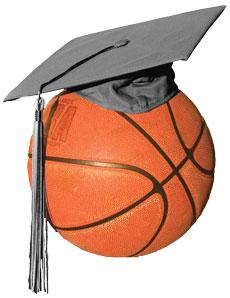ATHLETES & ACADEMICS

ATHLETES & ACADEMICS
Are athletes better students?
Statistics from the NCAA show that from 1998 to 1999 Missouri Southern had a 32 percent graduation rate of all students, and a 40 percent rate for athletes.
“I think having our average GPA of nearly 400 athletes over a 3.0 is definitely saying something,” said Justin Maskus, director of sports information.
Last spring, the Southern football team’s overall grade-point-average was 2.96 and last fall it was 2.76.
“That’s not super good, but it’s higher than the average student,” said head football coach Bart Tatum. “In my two semesters I’ve been here, our team’s GPA has been significantly higher than the student body’s.”
To some athletes, like Elbert Johnson, senior marketing management major and defensive lineman on the football team, keeping a solid GPA is vital.
“You have to keep your scholarship and manage your time between practice, school and games,” Johnson said. “(Athletes) have a lot on their plate.”
The campus overall GPA last fall was 2.96. For athletes alone, which comprise 6.6 percent of the student population, the athletes’ GPA for last fall was 3.04.
Tom Rutledge, head coach of track and field, said athletes have no choice but to keep high GPAs in order to stay eligible for sports.
“I do dismiss students if they start to drop,” Rutledge said. “I check grades every six weeks. We feel like athletes have to self-discipline a lot. We’re not saying they’re better than the normal students, it’s just that they do have an extra load.”
Erin Steffens, freshman radiology major and thrower for the track team, said athletes are put on a higher standard than the average student.
“Coaches expect us to do well in classes,” Seffens said.
To some coaches, like head softball coach, Aron Potter, being an athlete doesn’t matter in the classroom.
“Where a student comes from, their upbringing and past experiences are what make them as a student,” she said.
Ashley Wright, senior criminal justice major and middle hitter for volleyball, said she agreed with the idea that sometimes athletes aren’t necessarily better students.
“We have to keep up our grades, but I think other students work hard as well,” Wright said. “It just depends on the person’s drive.”
Tatum said when he researched athletes’ success in the classroom for his dissertation, he found inconsistent results. However, the level of division status could affect the results.
“There’s a major difference; Division II schools aren’t football factories,” he said. “We are an educational deal at this level, so our guys have a much different approach.”
To athletes who aren’t on a scholarship, affording higher education creates a time issue.
“I would say half of my 35 kids have outside jobs,” Rutledge said. “Which means they work 20 hours a week, put in 20 hours a week for practice and then they have class on top of that. So we’re looking at 60 hours a week easy that they’re having to do, and still being able to keep up their GPAs.”
Rutledge also said possible employers of his past athletes receive a good recommendation.
“I tell people wanting a reference if a kid can make it through four years of my program I tell them that he’ll be the first to work, the last to leave and you’re an idiot if you don’t hire them,” he said.
Your donation will support the student journalists of Missouri Southern State University. Your contribution will allow us to purchase equipment and cover our annual website hosting costs.















